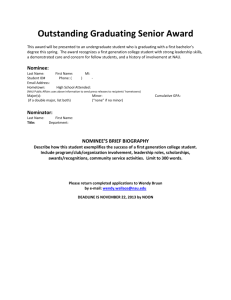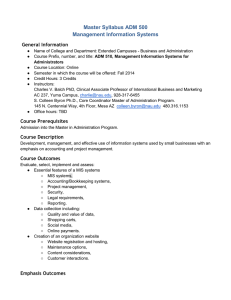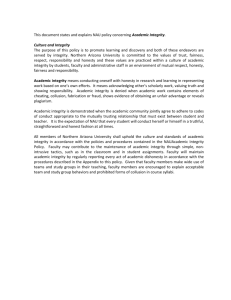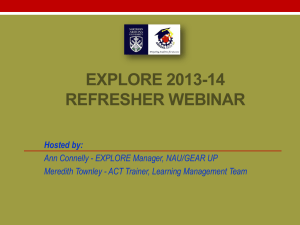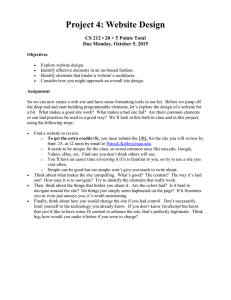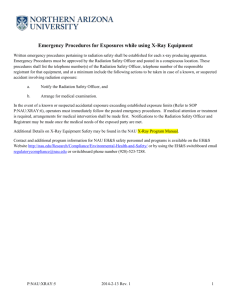Answer 22-23 for UCC/ECCC only
advertisement
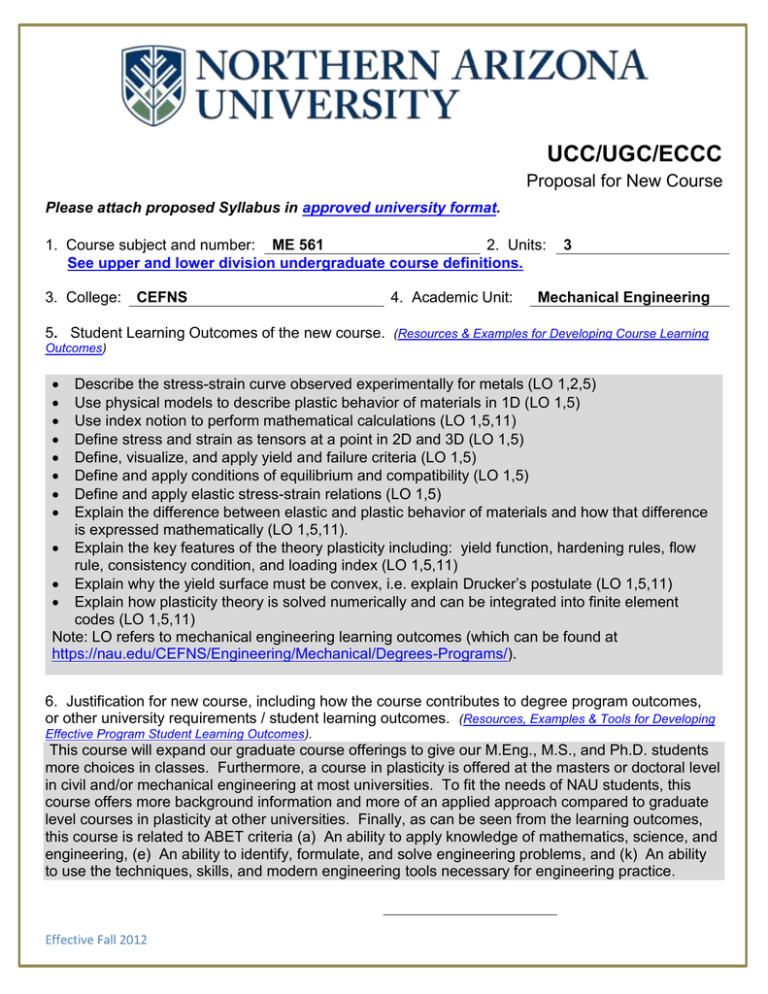
UCC/UGC/ECCC Proposal for New Course Please attach proposed Syllabus in approved university format. 1. Course subject and number: ME 561 2. Units: See upper and lower division undergraduate course definitions. 3. College: CEFNS 4. Academic Unit: 3 Mechanical Engineering 5. Student Learning Outcomes of the new course. (Resources & Examples for Developing Course Learning Outcomes) Describe the stress-strain curve observed experimentally for metals (LO 1,2,5) Use physical models to describe plastic behavior of materials in 1D (LO 1,5) Use index notion to perform mathematical calculations (LO 1,5,11) Define stress and strain as tensors at a point in 2D and 3D (LO 1,5) Define, visualize, and apply yield and failure criteria (LO 1,5) Define and apply conditions of equilibrium and compatibility (LO 1,5) Define and apply elastic stress-strain relations (LO 1,5) Explain the difference between elastic and plastic behavior of materials and how that difference is expressed mathematically (LO 1,5,11). Explain the key features of the theory plasticity including: yield function, hardening rules, flow rule, consistency condition, and loading index (LO 1,5,11) Explain why the yield surface must be convex, i.e. explain Drucker’s postulate (LO 1,5,11) Explain how plasticity theory is solved numerically and can be integrated into finite element codes (LO 1,5,11) Note: LO refers to mechanical engineering learning outcomes (which can be found at https://nau.edu/CEFNS/Engineering/Mechanical/Degrees-Programs/). 6. Justification for new course, including how the course contributes to degree program outcomes, or other university requirements / student learning outcomes. (Resources, Examples & Tools for Developing Effective Program Student Learning Outcomes). This course will expand our graduate course offerings to give our M.Eng., M.S., and Ph.D. students more choices in classes. Furthermore, a course in plasticity is offered at the masters or doctoral level in civil and/or mechanical engineering at most universities. To fit the needs of NAU students, this course offers more background information and more of an applied approach compared to graduate level courses in plasticity at other universities. Finally, as can be seen from the learning outcomes, this course is related to ABET criteria (a) An ability to apply knowledge of mathematics, science, and engineering, (e) An ability to identify, formulate, and solve engineering problems, and (k) An ability to use the techniques, skills, and modern engineering tools necessary for engineering practice. Effective Fall 2012 7. Effective BEGINNING of what term and year? Fall 2015 See effective dates calendar. 8. Long course title: ENGINEERING PLASTICITY (max 100 characters including spaces) 9. Short course title: ENGINEERING PLASTICITY (max. 30 characters including spaces) 10. Catalog course description (max. 60 words, excluding requisites): This course is a practical approach to modeling the plastic behavior of materials. Topics include: physical models, index notion, elastic stress-strain relations, yield and failure criteria, perfectly plastic models, work hardening models, and integration of models into finite element software. Prerequisites: ME 365 (Machine Design) or CENE 376 (Structural Analysis I), and MAT 239 (Differential Equations) with grade greater than or equal to C. 11. Will this course be part of any plan (major, minor or certificate) or sub plan (emphasis)? Yes No If yes, include the appropriate plan proposal. Mechanical Engineering; M.S.E. / MENG Elective. No related plan changes are needed. 12. Does this course duplicate content of existing courses? Yes No If yes, list the courses with duplicate material. If the duplication is greater than 20%, explain why NAU should establish this course. 13. Will this course impact any other academic unit’s enrollment or plan(s)? Yes No If yes, describe the impact. If applicable, include evidence of notification to and/or response from each impacted academic unit 14. Grading option: Letter grade Pass/Fail Both 15. Co-convened with: 14a. UGC approval date*: (For example: ESE 450 and ESE 550) See co-convening policy. *Must be approved by UGC before UCC submission, and both course syllabi must be presented. 16. Cross-listed with: (For example: ES 450 and DIS 450) See cross listing policy. Please submit a single cross-listed syllabus that will be used for all cross-listed courses. 17. May course be repeated for additional units? 16a. If yes, maximum units allowed? 16b. If yes, may course be repeated for additional units in the same term? 18. Prerequisites: Effective Fall 2012 ME 365 (Machine Design) or Yes No Yes No CENE 376 (Structural Analysis I), and MAT 239 (Differential Equations) with grade greater than or equal to C. If prerequisites, include the rationale for the prerequisites. Topics from these courses will directly used in ME 561. In particular the stress/strain analysis from ME 365 or CENE 376 will be used and plasticity theory is built on a system of differential equations, so students must have knowledge from MAT 239. These classes are typically completed by the senior year in both civil and mechanical engineering 19. Co requisites: If co requisites, include the rationale for the co requisites. 20. Does this course include combined lecture and lab components? Yes If yes, include the units specific to each component in the course description above. 21. Names of the current faculty qualified to teach this course: No Heidi Feigenbaum 22. Classes scheduled before the regular term begins and/or after the regular term ends may require additional action. Review “see description” and “see impacts” for “Classes Starting/Ending Outside Regular Term” under the heading “Forms” http://nau.edu/Registrar/Faculty-Resources/Schedule-of-Classes-Maintenance/. Do you anticipate this course will be scheduled outside the regular term? Yes No 23. Is this course being proposed for Liberal Studies designation? If yes, include a Liberal Studies proposal and syllabus with this proposal. Yes No 24. Is this course being proposed for Diversity designation? If yes, include a Diversity proposal and syllabus with this proposal. Yes No Answer 22-23 for UCC/ECCC only: FLAGSTAFF MOUNTAIN CAMPUS Scott Galland Reviewed by Curriculum Process Associate 10/23/2014 Date Approvals: F. Ernesto Penado Department Chair/Unit Head (if appropriate) 10/20/2014 Date Chair of college curriculum committee Date Effective Fall 2012 Dean of college Date For Committee use only: UCC/UGC Approval Date Approved as submitted: Yes No Approved as modified: Yes No EXTENDED CAMPUSES Reviewed by Curriculum Process Associate Date Approvals: Academic Unit Head Date Division Curriculum Committee (Yuma, Yavapai, or Personalized Learning) Date Division Administrator in Extended Campuses (Yuma, Yavapai, or Personalized Learning) Date Faculty Chair of Extended Campuses Curriculum Committee (Yuma, Yavapai, or Personalized Learning) Date Chief Academic Officer; Extended Campuses (or Designee) Date Approved as submitted: Yes No Approved as modified: Yes No Effective Fall 2012 Plasticity Spring Semester 2013 NAU College of Engineering, Forestry and Natural Science Mechanical Engineering Department Instructor: Heidi Feigenbaum Office: Room 201 Phone: 523-5326 E-mail: hf38@nau.edu Office Hours: Mon. 1-3pm, Tues & Thurs 1-2pm, and by appointment Class Schedule: T/Th 11:10-12:25 PM, Engineering Rm. 218 Prerequisites: ME 365 (Machine Design) or CENE 376 (Structural Analysis I), and MAT 239 (Differential Equations) with grades of C or better. If you have not completed the prerequisites for a course as stated in the academic catalog, you may be administratively dropped from the course before the twenty-first day of the term. Do not rely on your instructor to drop you from the courses that you want to drop. You are responsible for changing your own course schedule. Course Description: This course is a practical approach to modeling the plastic behavior of materials. Topics include: physical models, index notion, elastic stress-strain relations, yield and failure criteria, perfectly plastic models, work hardening models, and integration of models into finite element software. 3hrs. Lecture. Learning Outcomes: Upon completion of this class, students will be able to: Describe the stress-strain curve observed experimentally for metals (LO 1,2,5) Use physical models to describe plastic behavior of materials in 1D (LO 1,5) Use index notion to perform mathematical calculations (LO 1,5,11) Define stress and strain as tensors at a point in 2D and 3D (LO 1,5) Define, visualize, and apply yield and failure criteria (LO 1,5) Define and apply conditions of equilibrium and compatibility (LO 1,5) Define and apply elastic stress-strain relations (LO 1,5) Explain the difference between elastic and plastic behavior of materials and how that difference is expressed mathematically (LO 1,5,11). Explain the key features of the theory plasticity including: yield function, hardening rules, flow rule, consistency condition, and loading index (LO 1,5,11) Explain why the yield surface must be convex, i.e. explain Drucker’s postulate (LO 1,5,11) Explain how plasticity theory is solved numerically and can be integrated into finite element codes (LO 1,5,11) Effective Fall 2012 Note: LO refers to mechanical engineering learning outcomes (which can be found at https://nau.edu/CEFNS/Engineering/Mechanical/Degrees-Programs/). Course Structure: For the most part, this is a traditional lecture-style class, however, I encourage questions from the class. During class, we will solve problems as a class or in small groups. Everyone MUST participate in solving these problems. Required Text: Plasticity for Structural Engineers, Wai-Fah Chen and Da-Jian Han, J. Ross Publishing, 2007. References: Introduction to Engineering Plasticity, G.K. Lal and N. Venkata Teddy, Alpha Science, 2009 Theory of Plasticity, J. Chakrabarty, 3rd edition, Elsevier Butterworth-Heinemann, 2006. Advanced Strength and Applied Elasticity, 5th Edition, Ansel C. Ugural and Saul K. Fenster, Pearson, 2012 Advanced Mechanics of Materials, 2nd edition, R. D. Cook, Prentice Hall, 1999 In addition, any calculus, mechanics of materials and elasticity textbooks are good references for this class. Grading System: RELATIVE WEIGHT Homework Midterm Exam 1 Midterm Exam 2 Project Total 25% 25% 25% 25% 100% As typical, 90-100% semester average will be an A, 80-90% semester average will be a B, 70-80% semester average will be a C, 60-70% semester average will be a D and less than 60% semester average will be a F. Exam grades may be scaled, but only if necessary and still subject to an absolute standard. Under no circumstances will homework or project grades be scaled. Course Policies: 1. Office Hours: Please honor the scheduled office hours, and make an appointment for alternate times. Not during scheduled office hours, if my door is open, I might be available to answer questions, however, if my door is closed, please respect that I am busy and come back at another time or email me to schedule an appointment. 2. Reading Assignments: I will not explicitly assign reading from the textbook. You are responsible keeping up to date with where we are in the textbook and reading along. Reading prepares you for and reinforces the lecture. Any outside reading assignments or handouts will be posted on BBLearn. Effective Fall 2012 3. Attendance: Regular attendance is expected (see policy in NAU general catalog: http://www4.nau.edu/academiccatalog/2010/Introduction/Important_Policies/Combined/ClassAtten d.htm). When absence is unavoidable, students assume the responsibility for any work they miss. Instructors are under no obligation to make special arrangements for students who have been absent unless the student has an institutional excuse. 4. Attitude and Conduct: You are expected to reflect the same professionalism that is expected of practicing engineers. At a minimum this means that you must be respectful to your classmates and me. No texting, sleeping, Internet searching, chitchatting, etc. during class. I will ask you to leave if you are not being respectful to me and/or other students. See http://home.nau.edu/studentlife/handbook/appendix_f.asp for NAU’s Classroom Management statement. 5. Academic Integrity: As defined in the Student Handbook (for additional information consult the handbook’s web page at http://home.nau.edu/studentlife/handbook.asp, Appendix G, Academic Dishonesty), academic integrity means that students and faculty jointly agree to adhere to a code of conduct appropriate to the mutually trusting relationship that must exist between student and teacher. Those values will not allow either to take credit for work not their own, or to be deceitful in any way, or to take unfair advantage of other students or of each other, or to be other than totally truthful and straightforward in all that they do. In particular, keep in mind that exceptionally high standards of honor and integrity are fundamental and essential to the study and practice of engineering. See Engineering Students' Professional and Code of Conduct Policy document from the college for more information. 6. Academic Dishonesty: Academic dishonesty is a form of misconduct that is subject to disciplinary action under the Student Code of Conduct. It will not be tolerated in this class and could result in failing the course or even expulsion from the college and university. If you are charged with academic dishonesty, you are subject to the Arizona Board of Regents’ Code of Conduct and procedures established by NAU that are outlined in the NAU Student Handbook. Academic dishonesty includes plagiarism, cheating, fabrication, fraud, and facilitating academic dishonesty. The possible consequences of academic dishonesty vary from a reduced or zero grade on the assignment or examination to a failing grade in the course. In extreme cases, suspension and/or dismissal from the university may be penalties, especially for students with past records of academic dishonesty. See the NAU Student Handbook, Appendix G, for more information and additional examples. Keep in mind that engineering is considered to be an ethical profession, and engineering students are expected to display the highest ethical standards. Furthermore, not knowing that certain activities qualify as academic dishonesty is not a defense to a charge of academic dishonesty. Cheating: is the intentional use of, or attempted use of, unauthorized materials, information, study aids, or previously prepared solutions in any academic exercise, exam, paper or other assignment. For example, a student who communicates with other students during an exam (either directly or through bits of paper, hand signals or electronic devices) or who uses materials that are not allowed in the exam. Another example is given by students who get up from their seats (to ask questions from the instructor or to go to the restroom) and cheat by glancing at other students’ papers. Conversely, a student may get up but leaves his/her exam uncovered, allowing other students to easily see their work (see also plagiarism below). Collusion: occurs when two or more students work together to produce individually submitted work without the permission of the faculty member. Collusion also occurs when one student produces work Effective Fall 2012 and knowingly allows another student to copy it and submit that copy for assessment. In such a case, both students will be considered to have colluded. Similarly, any student who helps another student to commit any type of academic dishonesty is considered to have colluded. Note that in engineering assignments it is OK to work in groups in order to discuss the solution to a problem, but the actual calculations performed to obtain the solution should be individually done. Fabrication/Fraud: is the unauthorized falsification or invention of any information, data, or citation in an academic exercise. It also includes any attempt to deceive a faculty member or administrative officer of the university regarding academic work. For example, a student who falsely uses illness or other form of extenuating circumstance to obtain an extension on an exam or assignment. As another example, consider a student whose final answer to a homework problem does not match the answer in the back of the book, but the student writes the answer in the book on his/her paper anyway. This is a fraudulent situation that can be easily detected, since it will be obvious that the calculations are inconsistent with the answer (and in some cases the answer in the book may be wrong). A similar situation occurs when a student presents a solution to a problem with insufficient calculations to justify the answer, and this answer magically matches the answer in the book or the answer obtained by other students in the class. Obtaining an unfair advantage: includes activities that directly or indirectly compromise fair assessment or grading or constrain other students’ abilities to successfully complete their assignments. As examples, consider gaining access to examination materials prior to the time authorized by the faculty member, or destroying reference materials with the result that others are deprived of their use, or circulating previously administered examinations (unless authorized by the faculty member). Plagiarism: representing the words, expressions, productions or creative works of another as one’s own in any academic exercise. For example, consider a student who simply copies the solution to a problem from others or from a solutions manual or from the solution to a similar problem assigned in a previous semester. Another example is given by a student who submits a computer assignment that is simply a copy (or effectively a copy) of another student’s work. An additional example is given by a student who either completely or partially copies a report or assignment from another student or even from the web. 7. Homework: It is impossible for you to do well in this course without doing the homework. a. Homework is part of your grade and is due at the beginning of the lecture period on the due date. Late homework will not be accepted. Exceptions to the late homework policy are allowable only under the NAU student excused policy guidelines (illness, official athletic activities, etc.) and written authorization from the appropriate medical or NAU authority is mandatory. If you have an institutional excuse, arrangements must be made with the instructor prior to the date when you will be absent. Remember also that you can always turn in an assignment early or electronically. b. In order to accommodate different circumstances, the lowest homework grade will be dropped at the end of the semester. c. High standards of workmanship are expected by the profession owing to the great responsibility attached to the practice of engineering, and similarly will be required for all homework assignments. Please pay particular attention to turning in a professional-looking assignment (neat, orderly, etc.). 8. Exams: Two midterms exams will be given during the semester. a. Make-up exams: Only under the most extreme circumstances will a make-up exam be given (e.g. illness or an institutional excuse). In all cases for a make-up exam to be given Effective Fall 2012 written authorization from the appropriate medical or NAU authority is mandatory. Such missed events must be rescheduled within one week of the subject absence, or prior to the final exam, whichever is sooner, and must be scheduled at least 48 hours in advance. Permission to take a make-up exam must be obtained prior to missing the exam. Only if there is an emergency will you be allowed to make up an exam that you missed without discussing your situation with me before the exam and again you must have written authorization. b. Re-grades: If you are unhappy with your grade on a midterm exam, you may submit the exam for re-grading. Please include with your exam a short memo explaining where you feel points were unfairly deducted. When you submit your exam for re-grading, the whole test will be re-graded and there is no guarantee that your grade will be better than what you had before. Re-grades must be submitted within one week of when the exam is returned to the class. University Policies: You can find additional important NAU academic policies at the links below. Please take a few minutes to review and become familiar with them. See http://www4.nau.edu/avpaa/UCCPolicy/plcystmt.html for policies on: Safe Environment Policy Students With Disabilities Institutional Review Board Academic Integrity Academic Contact Hour Policy Sensitive Course Materials See http://home.nau.edu/studentlife/handbook/appendix_f.asp for Classroom Management statement. You can find information about drop/add deadlines at the following link for the Office of the Registrar’s enrollment calendar website: http://nau.edu/Registrar/Important-Dates/Fall-Enrollment-Calendar2012/ Effective Fall 2012 TENTATIVE SCHEDULE** Day Tu Th Tu Th Tu Th Tu Th Tu Th Tu Th Tu Th Tu Th Tu Th Tu Th Tu Th Tu Th Tu Th Tu Th Tu Th DATE 15-Jan 17-Jan 22-Jan 24-Jan 29-Jan 31-Jan 5-Feb 7-Feb 12-Feb 14-Feb 19-Feb 21-Feb 26-Feb 28-Feb 5-Mar 7-Mar 12-Mar 14-Mar 26-Mar 28-Mar 2-Apr 4-Apr 9-Apr 11-Apr 16-Apr 18-Apr 23-Apr 25-Apr 30-Apr 2-May Topic Introduction Experimental Stress-Strain Curves & Mechanisms of plastic deformation Physical models for plastic behavior Index Notation Stress & Equilibrium Yield and Failure Criteria Strain & Deformation Elastic stress-strain relations Flow rule Review & Catch up MIDTERM EXAM 1 - Tenative Example Incremental stress-strain relations Convexity Hardening Loading index and consistency condition Incremental stress-strain relations Example: Isotropic hardening Project proposal discussions Example: Prager's kinematic hardening Example: Armstrong-Frederick kinematic hardening Example: Mixed hardening FE implimenation FE implimenation Numerical Algorithms for solving nonlinear equations Numerical Implementation Review & Catch up MIDTERM EXAM 2 - Tenative Project Presentations Project Presentations Chapters 1.3 1.4 1.5 2.1 2.2-2.4 3.1 3.2-3.3 4.1-4.3 4.7 4.8 4.6 5.1 5.2-5.3 5.7 5.6 5.6 5.6 5.6 6.1-6.3 6.1-6.3 6.4 6.5 ** This course outline is tentative and is likely to change over the course of the semester. I will not post updated schedules. It is your responsibility to stay up to date with the course including what we are covering in lecture and the topics to be covered on each exam. Effective Fall 2012
